Advertisements
Advertisements
प्रश्न
Analyse the main features of Phase-III (1951 - 81) of growth of population in India.
उत्तर १
- The decades 1951-1981 are referred to as the period of population explosion in India, which was caused by a rapid fall in the mortality rate but a high fertility rate of population in the country.
- The average annual growth rate was as high as 2.2 percent.
- It is in this period, after the Independence, that developmental activities were introduced through a centralised planning process and economy started showing up ensuring the improvement of living condition of people at large. Consequently, there was a high natural increase and higher growth rate.
उत्तर २
- The decades 1951-1981 are referred to as the period of population explosion in India, which was caused by a rapid fall in the mortality rate but a high fertility rate of population in the country.
- The average annual growth rate was as high as 2.2 percent.
- It was in this period, after the Independence, that developmental activities were introduced through a centralised planning process and economy started showing up, ensuring the improvement of living condition of people at large. Consequently, there was a high natural increase and higher growth rate.
APPEARS IN
संबंधित प्रश्न
With the help of suitable diagram describe the logistic population growth curve.
If 8 individuals in a population of 80 butterflies die in a week, calculate the death rate of the population of butterflies during that period.
Examine the following statement and correct the incorrect one.
There is an adverse impact on manpower in the regions of out-migration.
Answer the following question.
Compare, giving reasons, the J-shaped and S-shaped models of population growth of a species.
Identify the correct correlation :
A: Assertion; R: Reasoning
A: In stage 2, the death rate reduces but the birth rate is constant.
R: The population increases rapidly in stage 2.
Assertion: Population of a region does not change.
Reason: Birth rate, death rate and migration affect the population of a region.
Which one of the following is not a push factor?
What are the three components of population change?
Birth rate and death rate.
What is population doubling time?
Which country has the highest and lowest growth rate of the population respectively?
What is the impact of migration?
What are the components of population change?
Why do people migrate in large numbers from rural to urban areas in India?
How many stages/phases of population growth?
In how many years India's population will be doubled?
The growth of population rate per decade is ______.
What is the average sex ratio In India (2011)?
The continent that has the highest growth rate of population.
The continent that has the lowest growth rate of population.
Which one of the following is not a component of population change?
Which are the components of population change?
Which is the most populated country?
Consider the following statements and choose the correct option from the given options:
1. Population grown rapidly during the sixteenth and seventeenth centuries.
2. Expansion of world trade during the sixteenth and seventeenth centuries is an important cause of it.
When the birth rate is more than the death rate between two points of time, it is known as ______
Study the given graph carefully and answer the following question:
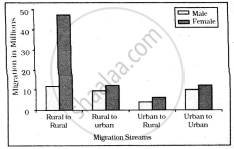
Intra-state Migration by place of Last Residence Indicating Migration Streams India, 2011
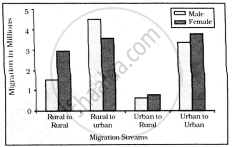
Inter-state Migration by Place of Last Residence Indicating Migration Streams India, 2011
Who dominates the intra-state migration of short distances?
The number of mice in a laboratory was 100 on a particular day. After one year their number increased to 120. Calculate the growth rate in the population.
On the basis of the demographic data of a country given below, construct an age pyramid and explain whether the population is stable, declining or growing.
| Age group | No. of individuals |
| Pre-reproductive | 20,000 |
| Reproductive | 15,000 |
| Post-reproductive | 10,000 |
Which of the following statement is true?
(i) CBR = Bi/P × 1000
(ii) COR = D /P × 1000
(iii) If birth rate is more than death rate, then CBR results in positive growth of population.
The term Crude Birth Rate (CBR) is closest to which of the following?
Which of the following pairs is not correctly matched?
Which of the following forms the component of a nation?
India's population is larger than the total population of which of the following?
What would be the per cent growth or birth rate per individual per hour for the same population mentioned in the previous question (Question 10)?
In 2005, for each of the 14 million people present in a country, 0.028 were born and 0.008 died during the year. Using exponential equation, the number of people present in 2015 is predicted as ______.
Comment on the growth curve given below.
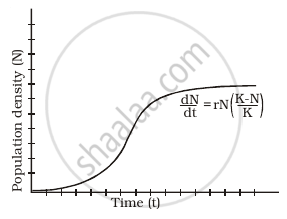
Swathi was growing a bacterial colony in a culture flask under ideal laboratory conditions where the resources are replenished. Which of the following equations will represent the growth in this case?
(Where population size is N, birth rate is b, death rate is d, unit time period is t, and carrying capacity is K).
Which of the following may be interpreted as a spontaneous effort to achieve a better balance between population and resources?
Analyse the different aspects of population growth in India during 1901-1921 and 1921-1951.
Assertion (A): Population of a region does not change.
Reasoning (R): Birth rate, death rate and migration affect the population of a region.
Which one of the following is the largest linguistic group of India?
A : Population of a region does not change.
R : Birth rate, death rate and migration affect the population of a region.
Assertion (A): Population of a region does not change.
Reasoning (R): Birth rate, death rate and migration affect the population of a region.
Assertion (A): Population of a region does not change.
Reasoning (R): Birth rate, death rate and migration affect the population of a region.
Assertion: Population of a region does not change.
Reasoning: Birth rate, death rate and migration affect the population of a region.
Study the two figures shown below that represent two growth models.
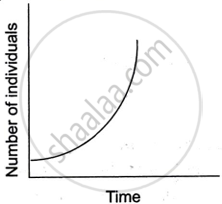 |
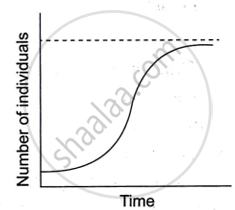 |
| Figure A | Figure B |
- Which one of the two figures represents an unlimited supply of nutrients? Give a reason.
- Which figure depicts a challenge to population growth?
- Explain the term reproductive fitness.
- Give the mathematical expressions for Figure A and Figure B.
Define the following term:
Growth rate of population
Assertion (A): Population of a region does not change.
Reasoning (R): Birth rate, death rate and migration affect the population of a region.
